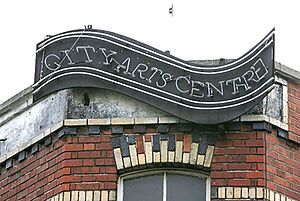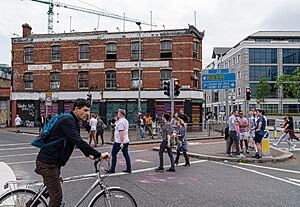City Arts Centre, Dublin facts for kids
| Formation | 1973 |
|---|---|
| Dissolved | 2012 |
| Purpose | Community arts centre in inner city Dublin, gallery, residencies, studios, music programmes |
The City Arts Centre (also known as CityArts) was a special place in central Dublin, Ireland. It was a community arts organization that started in 1973 and closed down in 2012. It aimed to bring art and culture to everyone, especially young people and those who might not have had many chances to experience art.
Contents
History of City Arts Centre
How it Started
The City Arts Centre first began in 1973 and was originally called the Grapevine Arts Centre. It moved around to different places in Dublin, like Mary Street and North Great George's Street, before finally buying its own building on Bachelor's Walk in 2010.
The idea for the centre came from a group of teenagers in Dublin. They felt there weren't many cultural activities for young people, especially for those from working-class families. This is why the centre was set up in the Northside inner city, which was not considered a fancy area at the time. The main people who started this project were Jackie Aherne, Anto Fahy, and Sandy Fitzgerald.
Growing as a Community Arts Hub
As the 1970s went on, the Grapevine Arts Centre became more focused on using art to help communities and bring about social change. They connected with similar groups in the UK, which helped them see culture in a new way. They believed that everyone should have equal access to art and culture.
By the early 1980s, the community arts movement in Ireland, including Grapevine, grew stronger. They worked to challenge old ideas about art and create new opportunities. In 1984, a group called CAFE (Creative Activity For Everyone) was formed, and Grapevine was one of its founding members.
The Grapevine's art programs were very varied and exciting. They took place inside the centre, in Dublin's neighborhoods, and all over Ireland. For example, they had street theatre shows led by Thom McGinty, who later became famous as the Diceman. They also offered hair cutting, street fashion design, audio art, and fun public events. They even had an interesting visual arts program, which included early shows by artists like John Kindness. They also organized an exhibition of drawings from survivors of Hiroshima, working with a young band called U2.
A New Name and Location
The connection with U2 continued. In 1988, the Grapevine Arts Centre changed its name to the City Arts Centre. It moved into a large warehouse building on Moss Street, near Tara Street Station. This became the biggest centre of its kind in Ireland. U2 helped by providing fully equipped rehearsal spaces in the basement for young bands. Above that, there was a cafe and a theatre space, and a gallery on the top floor. Sandy Fitzgerald was the Director until 2001.
The City Arts Centre actually owned the Moss Street building. This area later became very valuable. There was a plan to create a big community project with a nearby school and community hall. However, the Dublin Dockland Development Authority did not approve the idea, even though the local council and Arts Council supported it. This meant the City Arts Centre became a unique building in the changing docklands area.
Sandy Fitzgerald stepped down as director in 2000, after 27 years. In 2001, the City Arts Centre stopped receiving funding from the Arts Council.
The Centre Closes Down
After Sandy Fitzgerald left, Declan McGonagle became the new director. Under his leadership, the centre began to close down. It shut its doors for two years, and all the staff lost their jobs. A city councilor named Mannix Flynn said that Dublin lost an important arts community when the City Arts Centre closed.
The centre's building on Moss Street was sold in 2003 for over €4.2 million. This made it the wealthiest arts organization in Ireland at the time. After selling the building, the City Arts Centre worked from a small office for a few years. In 2007, it bought a smaller building on Bachelor's Walk. This new building needed repairs and only reopened in 2010, under the name CityArts.
By this time, the organization had spent almost all its money on running costs, archiving its history, staff payments, and the new building's renovations. In 2012, CityArts officially closed down. The new building on Bachelor's Walk became the property of Dublin City Council. As of 2021, the original Moss Street building was still unused, but it was put up for sale in April 2021 for €35 million.
In 2004, a book called 'An Outburst of Frankness: Community Arts In Ireland - A Reader' was published. This book, edited by Sandy Fitzgerald, shares many details about the history of community arts in Ireland.
Timeline of Key Events
Throughout its 25 years, the City Arts Centre hosted many popular events. Some of these events even got attention from the media and politicians.
- 1973 - The centre was founded.
- 1978/79 - It actively joined anti-nuclear protests, contributing to festivals with children's theatre, music, and public events. They also organized an anti-nuclear exhibition and debates.
- 1982 - The centre participated in and photographed a nuclear disarmament march.
- 1985 - Grapevine Arts Centre changed its name to City Arts Centre.
- 1989 - They held a Street Carnival.
- 1989 - The Moss Street City Arts Building officially opened.
- 1995 - The centre helped organize the South Docks Festival Parade and a Children's Day in Pearse Square.
- 2001 - All staff were made redundant.
- 2003 - The Moss Street building was sold for €4.2 million.
- 2007 - A new location was bought on Bachelor's Walk.
- 2012 - The centre officially closed down.
Images for kids
See also
 In Spanish: City Arts Centre para niños
In Spanish: City Arts Centre para niños





